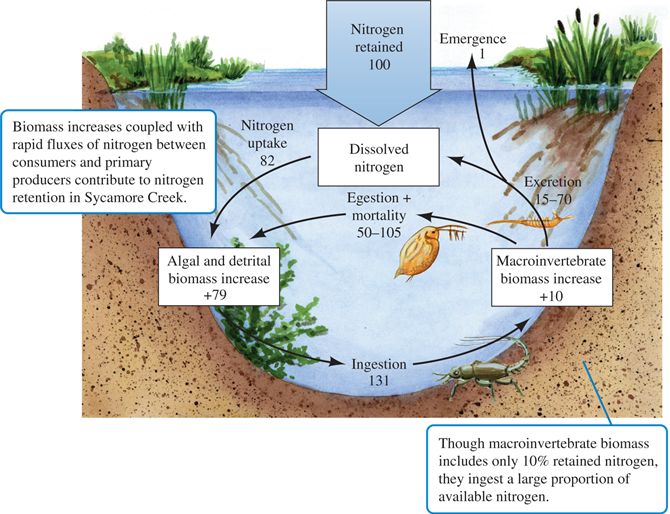 |
| Previous Image | Next Image |
| Description: Nancy Grimm (1988) showed that aquatic macroinvertebrates significantly increase the rate of nitrogen cycling in Sycamore Creek, Arizona. Streams in the arid American Southwest support high levels of macroinvertebrate biomass. Grimm estimated invertebrate population densities as high as 110,000 individuals per square meter and dry biomass as high as 9.62 g per square meter. More than 80% of macroinvertebrate biomass in Sycamore Creek was made up of species that feed on small organic particles, a feeding group that stream ecologists call collector-gatherers. The collector-gatherers of Sycamore Creek are dominated by two families of mayflies, Baetidae and Tricorythidae, and one family of Diptera, Chironomidae. Grimm quantified the influence of macroinvertebrates on the nitrogen dynamics in the creek, where primary production is limited by nitrogen availability. She developed nitrogen budgets for stream invertebrates, mainly insect larvae and snails, by quantifying their rates of nitrogen ingestion, egestion (defecation), excretion, and accumulation during growth. By combining these rates with her estimates of macroinvertebrate biomass, Grimm was able to estimate the contribution of macroinvertebrates to the nutrient dynamics of the Sycamore Creek ecosystem. Her measurements indicated that macroinvertebrates could play an important role in nutrient spiralling. To determine whether they play such a role, what information do we need? We need to know how much of the available nitrogen they ingest. If invertebrates ingest a large proportion of the nitrogen pool, then their influences on nitrogen spiralling may be substantial. Grimm measured the nutrient retention of Sycamore Creek as the daily difference between nitrogen inputs and outputs in her study area. These measurements showed an average rate of retention of nitrogen as 250 mg per square meter per day. Grimm set this rate of retention as 100% and then expressed her estimates of flux rates as a percentage of this total (fig. 20.17). Nitrogen ingestion rates by macroinvertebrates averaged about 131%. How can ingestion rates be greater than 100%? What this means is that the collector-gatherers in the study stream re-ingest nitrogen in their feces. This is a well-known habit of detritivores, many of which gain more nutritional value from their food by processing it more than once.
Picture Stats: Views: 1234 Filesize: 78.15kB Height: 514 Width: 670 Source: https://biology-forums.com/index.php?action=gallery;sa=view;id=2049 |
